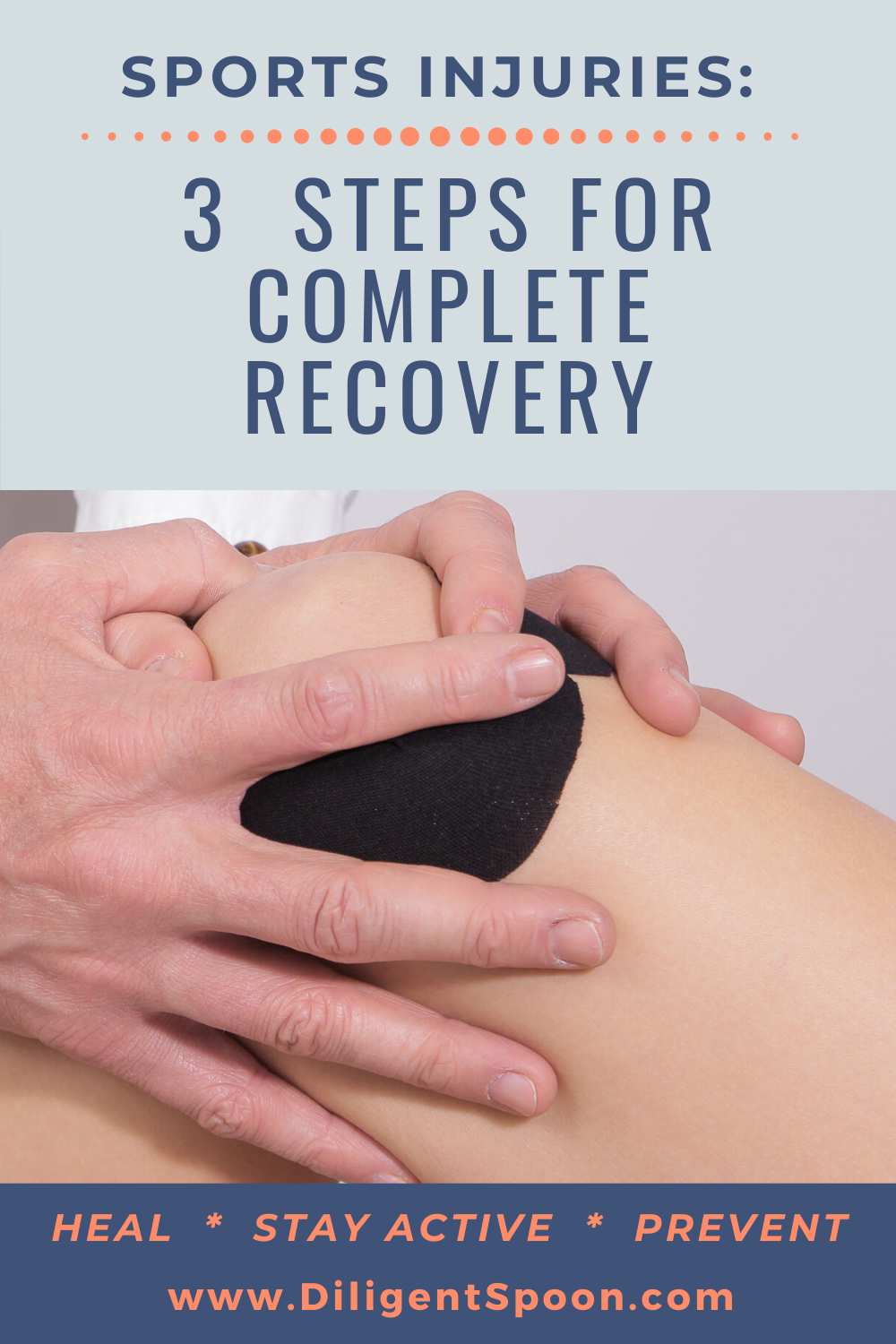
Sports Injuries: 3 Steps to Complete Recovery
So you’re injured. You were humming along, being your active self – running, playing tennis, crossfitting, etc. – and you feel a knee pop or wake up the next day with searing pain in your shoulder. Whether you suffer an acute injury, like breaking a bone, or an overuse ailment, such as plantar fasciitis; it’s common to feel angry, sad, or even depressed about it. For me, coping with the psychological impact of an injury is harder than the physical recovery! No matter how you feel, one thing is for certain – we all want to recover well, and recover as fast as possible. In this post, I share a few things I’ve learned about injuries, from my own experiences.
While we all a fast recovery, it’s more important to have a smart recovery. Smart recovery is more than just “taking it easy” for a while – it involves the mental and physical work of:
- Honoring your body and the healing process
- Staying strong and active, as you are able
- Addressing the underlying issues, or injury prevention
Honor Your Body and the Healing Process
I’m as guilty as anyone of throwing a pity party/adult fit when I get an injury. Maybe I’ll even deny the the injury for a while, exercising through the pain. Both of these options are bad ideas. It is important, however, to own and accept any feelings of anger, sadness, or depression that come with an injury. These emotions are real, just as real as the physical pain – finding ways to cope mentally with an injury is key to a smart recovery, and can help you become a more resilient and flexible athlete.
Side note: You may be asking yourself, “Am I an athlete?” Merriam-Webster defines athlete as “a person who is trained or skilled in exercises, sports, or games requiring physical strength, agility, or stamina”. So, if you’ve either trained for or practiced enough to be skilled in your sport or exercise, then you’re an athlete.
It’s Alright to Cry
So, you’re mad about being injured and depressed because you can’t run – now what? Just like the song says, “It’s Alright to Cry”! Let me suggest the following: Give yourself five minutes (set a timer even) to be as angry, sad, or pathetic as you like – throw yourself that pity party and scream “It’s not fair!” into an empty room. Get it all out, because after that, it’s time to recover and not waste energy on feeling sorry for yourself. After five minutes, accept (to varying degrees) that you have an injury. It’s time to get crackin’ on the healing part.
Decide If You Need Professional Health
Before you do anything, decide whether you need to see a healthcare provider and, if yes, make an appointment. Whether it’s a doctor at urgent care, or the physical therapist you’ve been seeing for a decade – if your intuition tells you to get an expert opinion, do it.
Stop Doing the Injury-Causing Activity
After 1) dealing with your emotions, and 2) seeing a professional as needed, steel yourself for the hardest part of healing. You must abstain from doing the activity that causes pain. If your injury is such that you cannot do some activities (eg, broken arm will prevent one from doing pull-ups), well then, this part will be easy. However, if you have an overuse injury – like plantar fasciitis or shin splints – please, please, resist the urge to work out through the pain. Why? You’ll make it worse. Recovery will take longer and the injury can develop from mild to severe. For example, shin splints may become stress fractures.
Listen to your body, intuition, doctor, or therapist and take the time off that you need – it will allow your body to heal completely and prevent re-injury or other setbacks in the future.
Stay Strong and Active
Even if you can’t (and shouldn’t) do certain activities or sports while injured, you can (and should) keep your body as strong and mobile as feasible. Cross training while injured will maintain your cardiovascular fitness, keep the rest of your body strong, and improve your sense of well being.
Cross-Training is Your Friend
When picking a cross training activity, think in terms of 1) what equipment or facilities you have access to, and 2) whether the activity will aggravate your injury.
For example, swimming or aqua jogging are awesome non-impact activities. However, if you are not a swimmer or don’t have access to a pool, then they won’t work for you. When I’m injured and need low/no impact options, my go-to cardiovascular workouts are elliptical machine, bike (stationary or actually riding my bike outside), row machine, or simply fast walking with hills. If you find machines incredibly boring, try rotating to a different machine every 10-15 minutes or listening to your favorite podcast while you work out.
Creative Cross-Training
If you find yourself with a more serious lower body injury – broken bone, badly sprained ankle – there are still creative options for keeping the rest of your body mobile and strong. Yoga, pilates, and upper body circuit workout (think curls, lat pull-down, tricep extensions, etc) will keep you strong and give you some cardiovascular benefit. Even if all you have is your living room floor, you can still do yoga online, stretch, do modified push-ups/planks, even “air curls” with you arms. Creative – yes. Effective – yes.
Do Your PT Exercises, Repeat …
Don’t forget those physical therapy exercises! If you’re like me, whenever you see your PT, you come home with 5 – 20 minutes of prescribed movement for healing. Even if you are cross training, do your PT exercises first, since they will not only keep you moving, but also help you heal and prevent future injury.
Address Underlying Issues = Prevention
You may know exactly what brought you to your injury – maybe you ran too hard without warming up and pulled a muscle, or tore your Achilles while lunging during a volleyball match. Whatever the cause, there are valuable insights that can be gained and applied to prevent a similar injury in the future.
If you’re working with a PT, he/she should assess your injury and body mechanics, and, from there, be able to help you correct imbalances, increase mobility, strengthen weak areas, etc. These strategies will help you heal faster. Plus, you’ll reduce the chance of having the same injury again. Again, make those assigned PT exercises top priority. They will add the most long-term value to your recovery.
A thoughtful PT will be best able to diagnose and treat your specific body and injury. If PT is not an option for you, there are great sources of information for a DIY approach to assessing and healing weak areas in your athletic body. My favorite resource is Anatomy for Runners by Jay Dicharry. The book includes explanations of the biomechanics of running, mobility and stability tests to assess your form, and corrective exercises. While it is written for runners, the principles can be applied to any athlete. To be clear, I do not think that a book or online reference is an adequate substitute for seeing a professional when you are seriously injured. A book like this will help you learn how to increase weak areas and prevent injury.
Let me be frank – after an injury, if you choose to NOT work on prevention, you are choosing INJURY over health. It is as simple as that.
Let me be frank again – I am not great at following these steps myself. Feeling sorry for myself, denying that I am hurt, and NOT doing PT exercises is easy and feels much better in the short run. Long-term, this has not served me! I have had several recurring injuries and have mostly learned my lesson: Only when I do these things – allow healing, cross train safely, and work on prevention – am I able to return to my favorite activities.
When you have an athletic injury, there are three important steps to making fast and full recovery:
- Honor your body and the healing process. Acknowledge the unfairness, accept the injury and let your body heal itself.
- Stay strong and active. To the best of your ability, maintain mobility and fitness by finding activities that you can enjoy without pain.
- Address the underlying issues to prevent future injury. Use available resources to figure out likely causes of the injury, and be diligent in fixing them.
Being hurt really stinks – no question. It’s also your body’s way of letting you know that it needs to repair itself. Our wonderfully amazing bodies will heal themselves. As good stewards of our physical selves, we can be intentional about allowing and aiding the healing process.
Have you been injured recently? What kind of healing experience(s) have you had, and what helped you recover? Please share your thoughts on this topic below!
Works Cited
“Cross Training While Injured.” Runners Connect, runnersconnect.net/running-questions/cross-training-while-injured/.
Dicharry, Jay. Anatomy for Runners: Unlocking Your Athletic Potential for Health, Speed, and Injury Prevention. Skyhorse Pub., 2012.
Thevendran, Gowreeson. “Fastest Ways to Heal a Sports Injury: A Medical Perspective.” Mount Elizabeth Hospital, Mount Elizabeth Hospital, 21 June 2017, www.mountelizabeth.com.sg/healthplus/article/fastest-ways-to-heal-a-sports-injury-a-medical-perspective.






3 Comments
Monica
Great post Brook! One piece of advice I have is to consider asking a professional before returning to your sport of choice. Your professional may be able to give you a more objective opinion. (Not that this has ever happened to me ;-))
Brook Hagen
Thanks for adding that tip, Monica! I know I’m the least objective person to assess my own injuries.
Morgan
Great timing! I’ve had a recent injury and one tip I can think of is to speak up to your doctors. They may be highly educated and know more about how your body works, but they can’t feel your pain. If you feel like something isn’t right, say something!